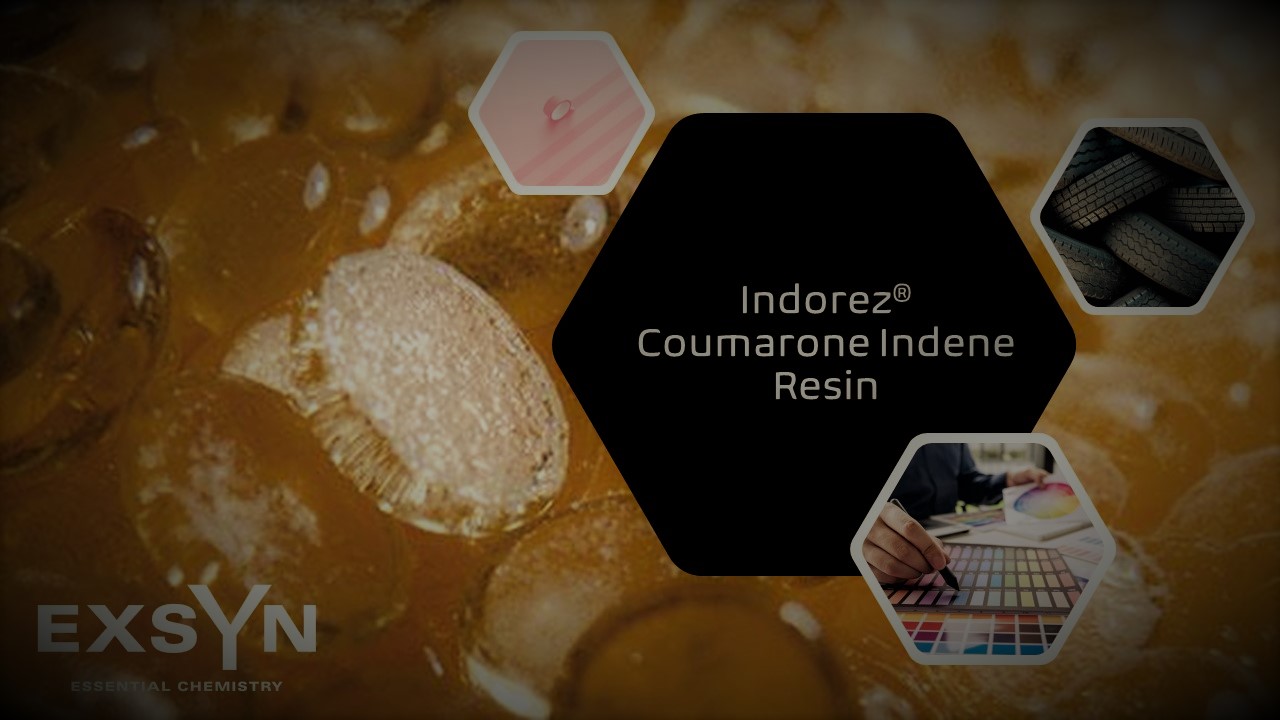INTRODUCTION
Indorez® Coumarone Indene Resin also known as CI Resin, is a thermoplastic aromatic resin which is produced through the polymerization of coumarone, indene & styrene. Each of these three ingredients play an important role in the performance of CI resin. Coumarone imparts cohesiveness and works as process aid, Styrene imparts heat resistance and Indene imparts transparency and better adhesiveness.
Coumarone Indene Resin has very good affinity with natural and synthetic rubbers. Its key characteristics include imparting good performance as a tackifier, softening and reinforcing agent.
These type of resins are designed to have excellent resistance to alkalis, dilute acids and moisture. They can improve the moulding operation, increase the hardness and elasticity of the product.
| Synonym | Coumarone Resin |
| CAS no. | 63393-89-5 |
| Molecular Formula | C8H6O |
SPECIFICATIONS [OC-100 – Typically used grade in rubber industry]
| Test | Unit | Specification |
|---|---|---|
| Appearance | – | Brownish Transparent Granules |
| Colour | Ga# | Max 18 |
| Softening Point (Ring & Ball) | °C | 90 – 100 |
| Acid Value | mgKOH/g | Max 0.30 |
| Ash | % | Max 0.05 |
APPLICATIONS
Excellent tack retention, higher adhesive bond strength, etc. are some important characteristics of Coumarone Indene resins which makes it a resin of choice in rubber, coatings and adhesive applications. CI resin is used as a tackifier and softener for natural and synthetic rubber.
| Applications |
|---|
| Rubber Compounds, Tyres, Tubes, Belts & other Rubber products |
| Adhesives and Adhesive tapes |
| Varnishes, Anti-Corrosive Paints & Coatings |
| Printing Inks |
PACKAGING
25 Kg Bags
STORAGE
Store in a sheltered place away from sources of heat and moisture.
No matter the quantity you need, our exceptional quality and service will make ExSyn your supplier of choice! If you need any additional information or SDS, please get in touch with us.
Iodine is anon-metallic, dark-grey/purple-black, lustrous, solid element. It is the heaviest and the rarest of stable halogens that can be found on the crust of earth.About fifty percent of all iodine produced and manufactured worldwide is used to form Organoiodine compounds. Iodine is an important element for many health-sustaining processes and essential for human thyroid health.
The product, acronymed Oct-NBE, is an organic compound with a cyclic ring system and a 8-membered hydrophobic chain. The structure renders the chemical special properties leading to its applications in diverse fields.
Nicotine is a hygroscopic, colorless to slight yellow, oily liquid, that is readily soluble in alcohol, ether or light petroleum. It is widely used recreationally as a stimulant and anxiolytic.
The product, acronymed ETD, is an organic compound with a fused bicyclic ring system and an ethylidene group. The structure renders the chemical special properties leading to its applications in diverse fields.
Sodium perchlorate monohydrate is the inorganic compound with the chemical formula NaClO4•H2O. It is the common existence form of sodium perchlorate, which can gradually absorb water in the air to form the monohydrate. Sodium perchlorate monohydrate is white rhombic crystal which is highly soluble in water and in alcohol. Its capacity to undergo redox reactions, liberating oxygen atoms, has been harnessed in the preparation of specialty chemicals, including pharmaceutical intermediates and fine chemicals.
Triphenylphosphine is a common organophosphorus compound that is frequently abbreviated as PPh3 or Ph3P. It is widely used in organic and organometallic compound synthesis because it is an effective reducing agent as well as a neutral ligand. At room temperature, PPh3 crystals are relatively air-stable and colourless.
Potassium chlorate holds significant importance across various industries due to its diverse applications. This white crystalline compound has been utilized for centuries as an essential ingredient in the production of matches, fireworks, and explosives, owing to its ability to release oxygen upon decomposition.
Podophyllotoxin is a non-alkaloid toxin lignan extracted from the roots and rhizomes of Podophyllum species. It is an organic heterotetracyclic compound that has a Furonaphthodioxole skeleton bearing a 3,4,5-trimethoxyphenyl substituent.
Octadecylphosphonic acid (ODPA), a versatile chemical compound, serves as a surfactant and dispersant in applications spanning coatings, lubricants, and corrosion inhibition. With its hydrophobic octadecyl chain linked to a phosphonic acid group, it excels in surface modification, boosting adhesion in metal surfaces.
